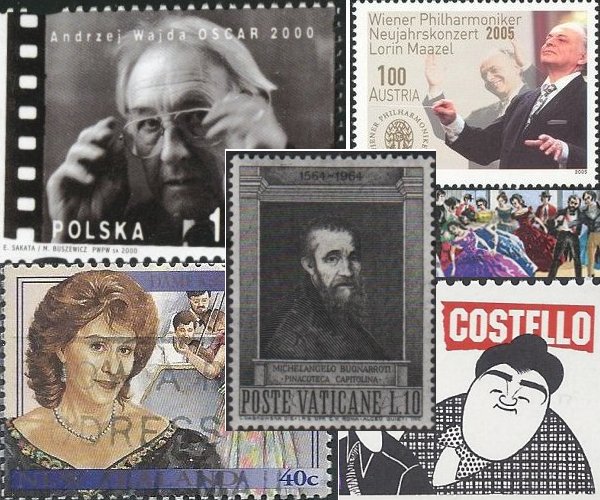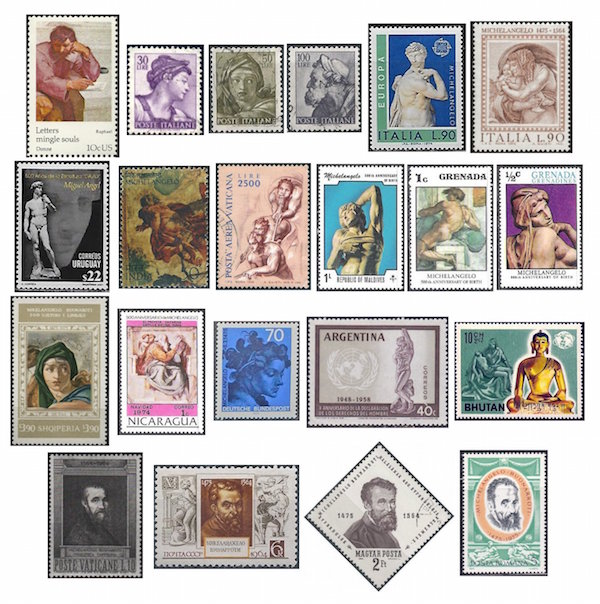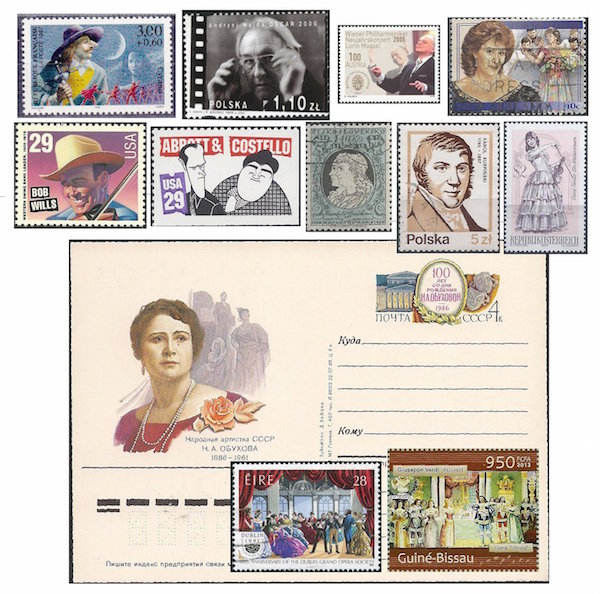The Arts on the Stamps of the World — March 6
An Arts Fuse regular feature: the arts on stamps of the world.

By Doug Briscoe
March 5th can boast Correggio and Tiepolo, but March 6th does them one better with Michelangelo. It’s a big topic, so as a stamp collector and a lover of classical music I’ll concentrate on the philately and the musical connections, starting with the latter. Michelangelo di Lodovico Buonarroti Simoni (6 March 1475 – 18 February 1564) was not only a great artist but an occasional poet. Britten composed his “7 Sonnets of Michelangelo” in 1940 and Shostakovich his “Suite on Verses by Michelangelo Buonarroti” in 1974. Among many other settings are ones by Hugo Wolf, Richard Strauss, Hans Pfitzner, Luigi Dallapiccola, Nicholas Maw, and Aribert Reimann, whose own birthday was just two days ago. I spoke yesterday of the “voluminous” numbers of Correggio stamps. Those numbers pale in comparison. The one from the US was not, as you might expect, for Christmas, but for the promotion of letter writing, a lovely set of reproductions on that topic from various periods and cultures. Next to that come three stamps from a series of Italian definitives from 1961. These denominations all show details, many of them very famous, from the Sistine Chapel, and are extremely common—buy a bag of a hundred mixed worldwide stamps and you’ll likely find a few of these inside. Two later Italian designs, one of Michelangelo’s “other” David, and one for the quincentenary, are less commonly found but still very inexpensive. The famous David is seen on a nice Uruguayan issue. The rest of this and the entirety of the next rows are given over to various art works by the master, the last of them an intriguing juxtaposition of the Pietà with the Buddha in a stamp from Bhutan. In the bottom row is an array of portrait stamps from various nations.
Baptised on this day in 1619 was the French writer and swashbuckler Cyrano de Bergerac. He is a figure who would deserve our admiration even if he hadn’t been immortalized in Edmond Rostand’s famous play of 1897. I was perfectly unaware, for example, that in addition to his dramas and letters Cyrano wrote two of the earliest science fiction stories: the Comical History of the States and Empires of the Moon (original title L’Autre Monde: ou les États et Empires de la Lune) and The States and Empires of the Sun (both published posthumously in 1657 and 1662 respectively.). He was only 36 when he died on 28 July 1655, possibly as the result of wounds received when he defended the Duc D’Arpajon against an assassination attempt. Besides Rostand’s play, there is an operetta by Victor Herbert (1899, a flop) and two grand operas, one by Walter Damrosch (premièred at the Met in 1913) and one from 1936 by Franco Alfano (whose birthday is the day after tomorrow).
One of the great Polish film directors, Andrzej Wajda (AHN-jay VY-da) was born on 6 March 1926. He passed away just months ago, 9 October 2016, at the age of 90. Wajda’s father was one of the thousands of murdered Polish officers at Katyń. (One of Wajda’s last films had this enormity as its subject.) Andrzej himself joined the resistance in 1942. After the war he had hopes of becoming a painter before attending film school. His first feature was A Generation (1954), the first of the war trilogy of films that still holds its place among the best work in his oeuvre. He went on to direct three dozen more features as well as work for television and theater productions. Though four times nominated for an Academy Award, he never won, but did receive an Honorary Oscar in 2000. For that accolade he was celebrated on a Polish stamp the same year.
Lorin Maazel (1930 – July 13, 2014) was born in France to musical Jewish-American parents of Russian descent. A child prodigy, he conducted his first orchestra at the age of eight and the NBC Symphony in a radio broadcast when he was eleven. Pierre Monteux was one of his teachers. Maazel was the first American to conduct at Bayreuth (1960), led the Berlin Opera and Berlin Radio Symphony Orchestra from 1964/5, and succeeded George Szell as music director of the Cleveland Orchestra in 1972. While still in that position he took on the directorship of the Orchestre National de France (till 1991). He went on to posts with the Vienna State Opera, the Pittsburgh Symphony, the Bavarian Radio Symphony Orchestra, and the New York Philharmonic and regularly appeared at the Vienna New Year’s Concerts (the stamp is one of several Austria issued to celebrate those concerts). He made over 300 recordings and was awarded the Grand Prix du Disque ten times. He was also a violinist and composer, writing an opera, 1984, after George Orwell’s novel.
Dame Kiri Janette Te Kanawa was born Claire Mary Teresa Rawstron in 6 March 1944 and was adopted as an infant. (Her own two children are also adopted.) She began as a popular entertainer, turning to opera in the mid-60s to great and almost immediate acclaim. In 1979 she appeared in Joseph’s Losey’s film of Don Giovanni, conducted by Lorin Maazel, with whom she shares this birthday! Three years later, Te Kanawa was named Dame Commander of the Order of the British Empire (DBE) and in subsequent years was appointed Honorary Companion of the Order of Australia (AC, 1990) and to the Order of New Zealand (ONZ, 1995). Dame Kiri remains active on the concert stage, although she has mostly curtailed her opera appearances. In 2013 she portrayed Nellie Melba in Downton Abbey.

Bob Wills (1905 – May 13, 1975) was known as the King of Western Swing (after the death of Spade Cooley, who had borne the same title). His father was a champion fiddler, and young Jim Bob took up that instrument and the mandolin. In 1934 he formed the Texas Playboys, a band that with its leaning toward jazz and the blues (Wills had once ridden a horse fifty miles to see Bessie Smith—”She was about the greatest thing I had ever heard. In fact, there was no doubt about it. She was the greatest thing I ever heard.”) achieved huge success, even outdrawing Tommy Dorsey and Benny Goodman. Wills also appeared in a number of movies in the 40s (he had joined the Army in 1942 but been given a medical discharge). A documentary about him was made in 2004.
Louis Francis Cristillo (1906 – March 3, 1959) went from his native New Jersey to Hollywood in hopes of becoming actor and found work as a stunt man. Dissatisfied, he came back east, changed his name to Costello, and met Bud Abbott. They went on radio on The Kate Smith Hour in 1938, and their immortal routine “Who’s On First?” made its debut on that program in that year. They had their own program from 1942 to 1949, then it was on to the movies and the kind of stardom young Louis Cristillo had sought years before. Abbott and Costello made three dozen pictures together, the last in 1956. “Lou Costello” succumbed to a heart attack three days before his 53rd birthday.

Josefina (or Josepha) Dušková (March 6, 1754 – January 8, 1824) was the wife of the composer and pianist Franz Xaver Dušek (Germanized as Duschek; “Dušková” being the distaff version of the masculine “Dušek”). She came of a well-to-do family and took music lessons with Dušek before becoming his wife in 1776. Her international success as a singer matched her husband’s as a pianist and teacher. She met Mozart in Salzburg in 1777, when he wrote the recitative and aria “Ah, lo previdi”, K. 272, for her. Ten years later he wrote for her another one, “Bella mia fiamma, addio”, K. 528. At this time Mozart was likely the couple’s houseguest. They later befriended Beethoven as well, and when he was in Prague in 1796 he composed his concert aria, “Ah! perfido”, Op. 65 for Josepha. The Czechoslovakian stamp shows the couple together and comes from a set recalling Mozart’s visit to Prague.
Karol Kazimierz (ka-ZEEM-yesh) Kurpiński (1785 – September 18, 1857) became a church organist when he was 12 and later played violin alongside his uncle, a cellist, in a count’s private orchestra. In Warsaw from 1810, he conducted the opera there and taught at several schools, one of which he himself founded. He was named Kapellmeister at the royal chapel in 1819 and started the first Polish music newsletter the next year. He wrote 26 operas, three ballets, a symphony, a clarinet concerto that has received at least three recordings, and some 50 polonaises, as well as two theoretical treatises. Another remarkable person very few of us have ever heard of.
Oscar Nathan Straus (1870 – 11 January 1954) was actually born Strauss, but changed the spelling so as to avoid confusion with the Vienna Strausses. Most of his music—500 cabaret songs, about two dozen operettas, two ballets, and music for about a dozen films—was written before he fled the Anschluss in 1939. In Paris he was awarded the Legion of Honor. Like so many other gifted refugees of the day, he wound up in Hollywood, but returned to Europe after the war. Straus has no personal stamp, but his famous operetta Ein Walzertraum (A Waltz Dream) appears on one of a set of six operetta stamps issued by Austria in 1970. (Incidentally, Ein Walzertraum had its première 110 years and three days ago, on 2 March 1907.) His other most famous work is The Chocolate Soldier (Der tapfere Soldat) of 1908. He also composed some orchestral, choral, and chamber music.
Nadezhda Andreyevna Obukhova (6 March [O.S. 22 February] 1886 – 14 August 1961) came from a musical and literary (and rich) family: her great-grandfather was the poet Yevgeny Baratynsky (his birthday was four days ago, and I searched high and wide for a stamp but came up empty-handed), her grandfather had been a pianist, and two of her uncles were professional singers, one of them also opera director of the Bolshoi Theater. She attended the Moscow Conservatory from 1907 and sang in concerts until making her operatic debut at the Bolshoi as Pauline in Tchaikovsky’s Queen of Spades in 1916. This role was to prove of some significance for her, as she sang Pauline’s aria as a performer in the very first radio concert in the USSR (1922), and she made her first recordings singing Pauline in 1937. She also took part in the first radio broadcast from the Bolshoi, this time in The Tsar’s Bride by Rimsky-Korsakov. Obukhova also enjoyed some success with popular songs. She went on performing to the end, dying just two months after her final concert.
Verdi’s opera La traviata, with libretto by Francesco Maria Piave, had its première at the Teatro la Fenice in Venice on this day in 1853. To commemorate the 50th anniverary of the Dublin Grand Opera Society, Ireland issued a stamp showing a scene from La traviata. The stamp from Guinea-Bissau purports to be for the same opera, but the costumes look a tad antiquated for this “contemporary” tale.
No stamps for Francis Beaumont (1584 – 6 March 1616) of Beaumont and Fletcher, nor for Elizabeth Barrett Browning (1806 – 29 June 1861), but seek not the cause of neglect among male chauvinists (this time), because Robert doesn’t have one either. Yet another British (French-born) writer, George du Maurier (1834 – 8 October 1896), author of the novel Trilby, remains stampless, too.
A graduate of the University of Massachusetts with a B.A. in English, Doug Briscoe worked in Boston classical music radio, at WCRB, WGBH, and WBUR, for about 25 years, beginning in 1977. He has the curious distinction of having succeeded Robert J. Lurtsema twice, first as host of WGBH’s weekday morning classical music program in 1993, then as host of the weekend program when Robert J.’s health failed in 2000. Doug also wrote liner notes for several of the late Gunther Schuller’s GM Recordings releases as well as program notes for the Boston Classical Orchestra. For the past few years he’s been posting a Facebook “blog” of classical music on stamps of the world, which has now been expanded to encompass all the arts for The Arts Fuse.
